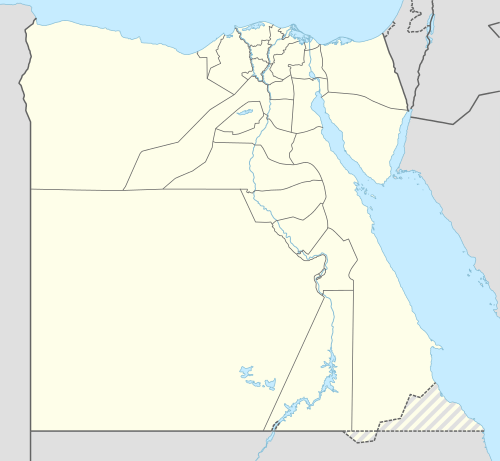Shalateen
| Shalateen شلاتين | |
|---|---|
 Shalateen Location within Egypt | |
| Coordinates: 23°7′54″N 35°35′8″E / 23.13167°N 35.58556°ECoordinates: 23°7′54″N 35°35′8″E / 23.13167°N 35.58556°E | |
| Country |
|
| Governorate | Red Sea Governorate |
Shalateen (Egyptian Arabic: شلاتين Šalatīn pronounced [ʃælæˈtiːn]; also spelled Alshalateen or Shalatin) is the biggest town just north of the Halayeb Triangle, Egypt. It is located 520 kilometres (320 mi) south of Hurghada and serves as the administrative center (markaze) of all Egyptian territory up to the border between Egypt and Sudan, including the villages of:
- Abu Ramad, 125 kilometres (78 mi) to the southeast;
- Halayeb, 165 kilometres (103 mi) to the southeast;
- Ras Hadarba 200 kilometres (120 mi) to the southeast. Ras Hadarba or Cape Hadarba lies on the shores of the Red Sea to the southeast of the city of Halayeb and to the east of mount Hadarba from which it takes its name. The village of Ras Hadarba lies just north of the borders between Egypt and Sudan which run along the 22 degree north parallel of latitude;
- Marsa Hameera, 40 kilometres (25 mi) to the north; and
- Abrak, 90 kilometres (56 mi) to the west.
The first three of the above towns (Abu Ramad, Halayeb and Ras Hadarba) are located within the disputed Halayeb Triangle.
History
Egyptian ministries and authorities are in the process of establishing their presence in the area and operate in conjunction with the City Council to provide services to the local communities according to the policies and programs of their respective organizations. The military is responsible for security and law enforcement in the Halayeb Triangle. Red Sea Governorate's Popular Council, including many members from the Bisharia and Ababda, are responsible for determining what the local people need and supporting local participation in management and development of this area.
The Egyptian government also provides additional social services to the local communities, such as food, water, monetary assistance, subsidies, health care, veterinary care, housing and education. A new international Airport in Marsa Alam was built, about 270 kilometres (170 mi) from Shalateen city, which Egyptian policy makers intend to be the center of more development for the southern region included the Shalateen area.
Climate
Köppen-Geiger climate classification system classifies its climate as hot desert (BWh).
| Climate data for Shalateen | |||||||||||||
|---|---|---|---|---|---|---|---|---|---|---|---|---|---|
| Month | Jan | Feb | Mar | Apr | May | Jun | Jul | Aug | Sep | Oct | Nov | Dec | Year |
| Average high °C (°F) | 25.5 (77.9) |
26.5 (79.7) |
28.3 (82.9) |
31.7 (89.1) |
34.7 (94.5) |
36.5 (97.7) |
37.4 (99.3) |
37.4 (99.3) |
36.1 (97) |
33.9 (93) |
30.4 (86.7) |
26.8 (80.2) |
32.1 (89.78) |
| Daily mean °C (°F) | 19.7 (67.5) |
20.4 (68.7) |
22.2 (72) |
25.3 (77.5) |
28.5 (83.3) |
30 (86) |
31.3 (88.3) |
31.5 (88.7) |
30.2 (86.4) |
28.1 (82.6) |
24.7 (76.5) |
21.3 (70.3) |
26.1 (78.98) |
| Average low °C (°F) | 14 (57) |
14.3 (57.7) |
16.1 (61) |
18.9 (66) |
22.4 (72.3) |
23.6 (74.5) |
25.3 (77.5) |
25.6 (78.1) |
24.4 (75.9) |
22.3 (72.1) |
19.1 (66.4) |
15.8 (60.4) |
20.15 (68.24) |
| Average precipitation mm (inches) | 0 (0) |
0 (0) |
0 (0) |
1 (0.04) |
0 (0) |
0 (0) |
0 (0) |
0 (0) |
0 (0) |
2 (0.08) |
9 (0.35) |
2 (0.08) |
14 (0.55) |
| Source: Climate-Data.org[1] | |||||||||||||
Ethnography
Local tribes in Halayeb and Shalateen area have had little exposure to modernization under Sudanese administration and under Egyptian administration up to 1992. But after 1992, the Egyptian government started to implement a development plan when it started to build some settlements, including 500 new houses built in Shalateen and 250 in Aboramad and Halayeb, depending on Shalateen local council sources. Roads were also established, including a 250-kilometer road between Shalateen and Marsa Alam city in north, and three new electricity generators have begun operation since 1993. In 1993–94, the Egyptian government launched a plan for the social economic development of the area. Services and economic support were delivered in the main towns and villages and necessary infrastructures was built. Financial and in-kind donations were sponsored for a total amount of 1.5 billion L.E. currently; the Government is supporting local families with 70 L.E. per month, and 3 L.E. per day to each child going to school. Nowadays many high educated people, and many local people, work as employees of the government, NGOs and private sector companies, which will help in more development.
Depending on that and on the government development policy, many people from the mountains moved to towns in order to benefit from these services. They were given houses with a permanent water source, food supplies, electricity and education. So far, approximately 8,000 people have settled along the coast. As a result of the plan, communities in the urban areas have improved their livelihood.
Local community in Halayeb area has been involved in the management of Gabel Elba Protected Area as guides and also as environmental researchers in the management and conservation of the natural resources of this area; local people are also involved in the decision making process. The World Food Program project in this area "Support Bedouin Life Project" represents a good model for the Egyptian government's policy of local participation and community-based management of projects.
References
- Notes
- ↑ "Climate: Al Shalaten - Climate graph, Temperature graph, Climate table". Climate-Data.org. Retrieved 14 August 2013.
- Sources
- Metrash,A.& Pozzan, E (2002). Preliminary Study of the Local Communities in Elba Protected Area,Report submitted for EIECP,EGYPTIAN ITALIAN ENVIRONMENTAL COOPERATION PROGRAM - PHASE II EEAA,Egypt
- World Food Program (2005),report about WFP projects in Egypt, also available via http://www.wfp.org/operations/current_operations/project_docs/104500.pdf
External links
- "Shalateen". Red Sea Governorate.